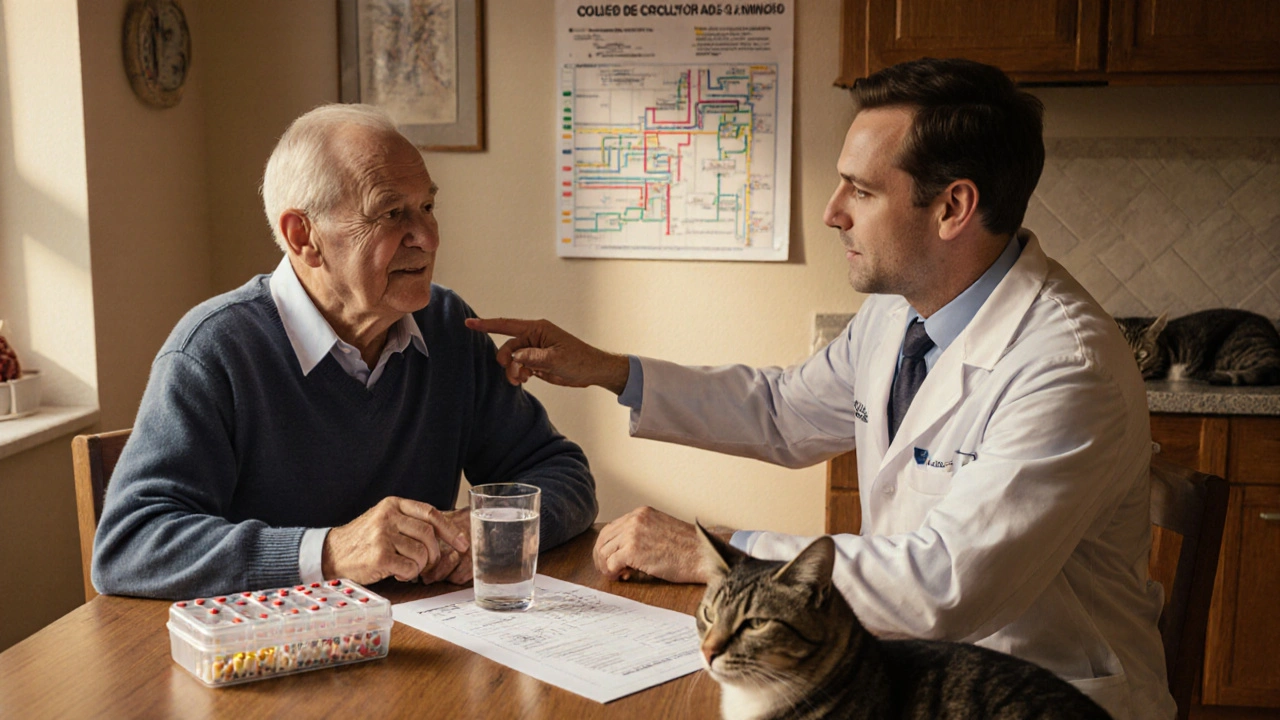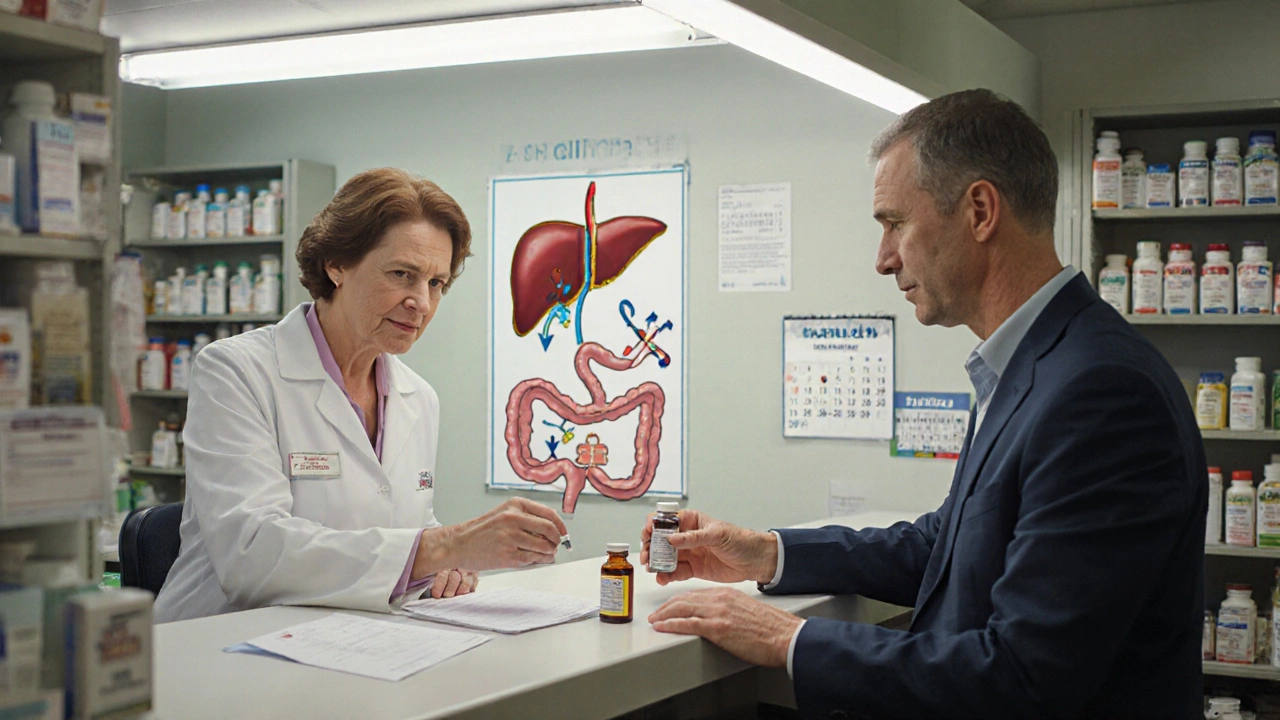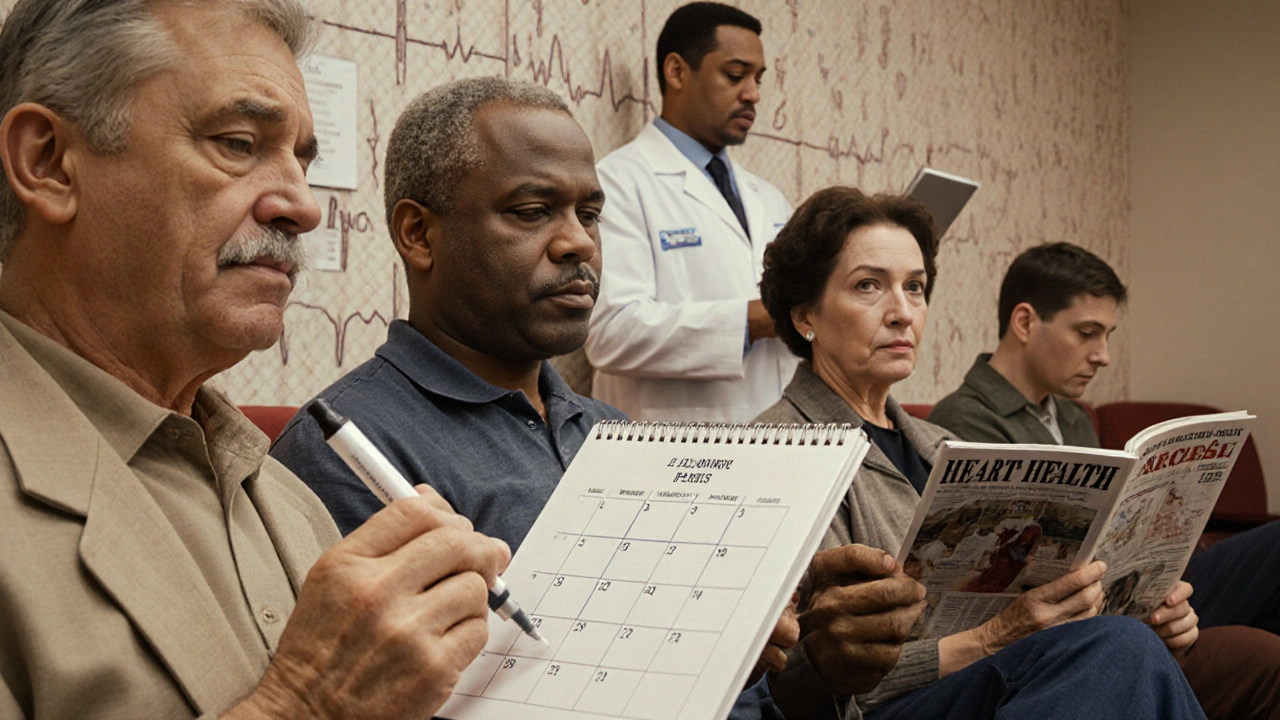Cholesterol-Lowering Medications: Statins vs. Alternative Options
 Nov, 20 2025
Nov, 20 2025
High cholesterol doesn’t always respond to diet and exercise alone. For millions of people, medication is the next step to protect their heart. And when it comes to lowering LDL - the so-called "bad" cholesterol - statins are still the go-to choice. But they’re not the only option. If you’ve tried a statin and felt muscle aches, or if your cholesterol won’t budge even on a high dose, you might be wondering: what else works?
How Statins Actually Work
Statins don’t just reduce cholesterol numbers on a lab report. They change how your liver works. These drugs block an enzyme called HMG-CoA reductase, which your liver uses to make cholesterol. When that enzyme is slowed down, your liver starts pulling more LDL cholesterol out of your blood to make up the difference. The result? Lower LDL levels - often by 30% to over 40%, depending on the drug and dose.Atorvastatin (Lipitor) and rosuvastatin (Crestor) are the most common statins used today. They’re powerful, well-studied, and backed by decades of data showing they cut heart attacks and strokes. In fact, studies tracking over 39,000 people found that every 1 mmol/L (39 mg/dL) drop in LDL cholesterol led to about a 20% lower risk of major heart events. That’s not a small gain - it’s life-changing.
But here’s the catch: doubling the statin dose doesn’t double the benefit. Going from 20 mg to 40 mg of atorvastatin might only drop LDL another 6%. That’s why doctors don’t just keep cranking up the dose. They look for other tools.
Why People Stop Taking Statins
About 1 in 4 people stop taking statins within the first year. Many say it’s because of muscle pain - aches, weakness, or cramps. That’s called statin-associated muscle symptoms. It’s real, but it’s not always the statin’s fault. Some people mistake normal aging for side effects. Others feel worse because they expect to.True statin-related muscle damage, like rhabdomyolysis, is extremely rare - less than 1 in 10,000 people. But even mild discomfort can be enough to make someone quit. The good news? Not all statins are the same. If simvastatin gives you trouble, switching to pravastatin or rosuvastatin might help. Those two are less likely to interact with other drugs and cause muscle issues.
Before giving up on statins, try this: stick with the same dose for 6-8 weeks. Give your body time to adjust. Talk to your doctor about trying a different statin. Or consider taking it every other day. Many people find relief without losing the cholesterol-lowering effect.
Alternative #1: Ezetimibe (Zetia)
Ezetimibe doesn’t touch your liver. Instead, it works in your gut. It blocks the absorption of cholesterol from food and bile, so less of it ends up in your bloodstream. Alone, it lowers LDL by about 15-22%. Not as much as a statin - but when you add it to a low-dose statin, the combo drops LDL by 21-27%.That’s why doctors often add ezetimibe when statins alone aren’t enough. It’s taken as a daily pill, no injections. Side effects are mild - maybe a little stomach upset. And unlike statins, it doesn’t cause muscle pain. One patient on Reddit said: "Zetia alone got my LDL from 190 to 160. Added to my low-dose simvastatin? Down to 110. No muscle issues at all."
It’s not a replacement for statins, but it’s a reliable helper. The National Institute for Clinical Excellence (NICE) recommends it for people who can’t tolerate statins - or need a little extra push.

Alternative #2: PCSK9 Inhibitors (Praluent, Repatha)
If your LDL is still sky-high even on a statin and ezetimibe, you might be a candidate for a PCSK9 inhibitor. These are injectable drugs - given under the skin every two or four weeks. They work by disabling a protein called PCSK9, which normally tells your liver to destroy LDL receptors. Block PCSK9, and your liver keeps more receptors alive to mop up cholesterol.These drugs can slash LDL by up to 60%. In people with existing heart disease, they reduce the risk of heart attack or stroke by 20%. And unlike statins, they don’t raise the risk of bleeding in the brain - making them safer for people who’ve had a hemorrhagic stroke.
But there’s a big downside: cost. A year of PCSK9 inhibitors can run $5,850. Generic statins? As low as $4 a month. Insurance often fights coverage. One patient shared: "Repatha dropped my LDL from 220 to 60 in three months. But my insurance denied it three times before approving it."
Still, for high-risk patients - those with familial hypercholesterolemia or recurrent heart events - these drugs can be life-saving. They’re not for everyone. But for some, they’re the only path to safe cholesterol levels.
Alternative #3: Bempedoic Acid (Nexletol)
Approved in 2020, bempedoic acid is a newer option that works in the liver, like statins - but in a different way. It blocks an enzyme called ACL, which is involved in cholesterol production. Unlike statins, it doesn’t enter muscle tissue, so muscle pain is rare.As a standalone pill, it lowers LDL by about 17%. When paired with a statin, it adds another 15-20% drop. It’s taken once daily. Side effects are usually mild - maybe a bit of joint pain or elevated uric acid (which can trigger gout in susceptible people).
This one’s a solid middle ground. More effective than ezetimibe, safer on muscles than statins, and cheaper than PCSK9 inhibitors. It’s not a first-line drug, but it’s a smart choice when statins aren’t tolerated and injections aren’t wanted.
Alternative #4: Inclisiran (Leqvio)
This one’s a game-changer in delivery. Inclisiran is a small RNA drug that silences the PCSK9 gene at the source. You get two injections a year - once in December, once in June. It lowers LDL by 40-50% when used with a statin.Think of it like a "set it and forget it" option. No daily pills. No weekly shots. Just two visits a year. It’s especially helpful for people who struggle with adherence - the kind who forget pills or hate injections.
It’s not cheap, but its long-acting nature may balance out cost over time. And because it’s not metabolized by the liver or muscles, drug interactions and muscle side effects are minimal. It’s approved in the U.S. and Australia, and growing in use among specialists.

What About Supplements?
You’ve probably seen ads for red yeast rice, plant sterols, or fish oil as "natural cholesterol fighters." Red yeast rice contains a compound similar to statins - and carries the same muscle risks. Plant sterols can lower LDL by 5-15%, but only if you take them with meals every day. Fish oil helps triglycerides, not LDL.Harvard Health put it plainly: "Statins lower harmful LDL cholesterol better than dietary supplements." The American College of Cardiology says supplements should never replace prescribed medication. They might help a little - but not enough to protect your heart on their own.
How Doctors Decide What’s Right for You
There’s no one-size-fits-all. Your doctor considers:- Your LDL number - how high is it?
- Your heart disease risk - do you have diabetes, high blood pressure, or a family history?
- Previous side effects - did you have muscle pain? Liver issues?
- Your lifestyle - can you manage daily pills? Injections?
- Your budget - can you afford a $5,000-a-year drug?
Most people start with a statin. If it works and you feel fine - great. If not, they’ll try a different statin first. If that fails, they’ll add ezetimibe. If you’re still high-risk and not at goal, then PCSK9 inhibitors or bempedoic acid come next. Inclisiran is becoming a favorite for those who need long-term, low-effort control.
And remember: cholesterol-lowering meds don’t replace diet, exercise, or quitting smoking. They work best when paired with healthy habits. But for many, they’re the difference between a future with heart disease - and one without.
What’s Coming Next?
Researchers are working on oral versions of PCSK9 inhibitors - no needles needed. There’s also gene-editing therapy in early trials that could permanently turn off PCSK9 production. These aren’t available yet, but they’re on the horizon.The goal isn’t to replace statins. It’s to give people more choices. Because managing cholesterol isn’t just about numbers. It’s about finding a treatment you can live with - for years, even decades.
Are statins the only effective cholesterol-lowering drugs?
No. While statins are the most common and best-studied option, other drugs like ezetimibe, PCSK9 inhibitors (Praluent, Repatha), bempedoic acid, and inclisiran are also proven to lower LDL cholesterol. Each works differently and is used based on individual needs, side effects, and risk levels.
Can I switch from a statin to a non-statin drug safely?
Yes, but only under medical supervision. Stopping a statin abruptly isn’t dangerous, but it can cause LDL to rise quickly. Your doctor will guide you on whether to replace it with another drug (like ezetimibe or bempedoic acid) or add one. Never stop or switch without talking to your provider.
Do alternative cholesterol drugs have fewer side effects than statins?
Some do. Ezetimibe and bempedoic acid rarely cause muscle pain, unlike statins. PCSK9 inhibitors and inclisiran don’t affect muscles at all. But each has its own risks - like joint pain with bempedoic acid or injection-site reactions with injections. The side effect profile depends on the drug, not just whether it’s a statin.
Why are PCSK9 inhibitors so expensive?
They’re biologic drugs - made from living cells - which makes them costly to produce. Manufacturers set high prices because they’re new and face little competition. Insurance often requires prior authorization, and many patients need help navigating appeals. Some drug manufacturers offer patient assistance programs to reduce out-of-pocket costs.
Is it better to take a statin with ezetimibe or switch to a PCSK9 inhibitor?
It depends on your risk and budget. For most people, adding ezetimibe to a statin is a cost-effective next step - it lowers LDL another 20% and costs pennies per day. For those with very high risk - like someone who’s had a heart attack - and can afford it, a PCSK9 inhibitor offers greater LDL reduction and proven heart protection. Your doctor will weigh the benefits against cost and convenience.
Can I take cholesterol meds if I’ve had a stroke?
Yes - but the type matters. If you had an ischemic stroke (caused by a clot), statins are still recommended. But if you had a hemorrhagic stroke (bleeding in the brain), statins may slightly increase your risk of another bleed. In that case, PCSK9 inhibitors are often preferred because they don’t raise bleeding risk. Always discuss your stroke history with your doctor before starting any cholesterol drug.
If you’re struggling with high cholesterol, you’re not alone. And you don’t have to settle for a drug that makes you feel bad. There are options - and your doctor can help you find the right one for your body, your life, and your future.

Mark Kahn
November 20, 2025 AT 23:17Hey, just wanted to say this post is a lifesaver. I was about to quit my statin until I read about trying a different one first. Switched from simvastatin to pravastatin and boom - no more muscle cramps. Still dropping my LDL like it’s nobody’s business. Thanks for the clarity!
Pravin Manani
November 22, 2025 AT 15:00From a clinical pharmacology standpoint, the mechanistic divergence between HMG-CoA reductase inhibition and PCSK9 modulation is fundamentally transformative in lipid management. The hepatic LDL receptor upregulation cascade induced by PCSK9 inhibitors represents a paradigm shift from substrate suppression to receptor preservation - a molecular triumph over evolutionary constraints.
Corra Hathaway
November 23, 2025 AT 04:38OMG YES. I’ve been on Inclisiran for 6 months now. Two shots a year?? I forgot I even had high cholesterol until my doc mentioned it last visit 😅 I used to hate pills. Now I just chill. #LifeChanging
Eliza Oakes
November 23, 2025 AT 13:03Wait… so you’re telling me Big Pharma doesn’t want us to know about ezetimibe because it’s too cheap?? 😏 I’m starting to think statins are just a money machine. They even made a whole drug category to replace themselves… with more drugs. Genius.
Leo Tamisch
November 25, 2025 AT 07:41Statins are the pharmaceutical equivalent of a 2008 Honda Civic - reliable, ubiquitous, and slightly underwhelming. Meanwhile, Inclisiran? That’s the Tesla of lipid therapy. Elon should invest. 🚀
Daisy L
November 26, 2025 AT 08:15Let me get this straight - you’re telling me I can take a pill that doesn’t hurt my muscles, costs less than my monthly coffee habit, and actually WORKS?? And we’ve been ignoring it for YEARS?? This is what happens when doctors listen to pharmaceutical reps instead of science!!
Noah Fitzsimmons
November 26, 2025 AT 17:11So… you’re saying the reason I can’t afford my meds is because my insurance company is run by people who think $5,000/year is ‘reasonable’? And my doctor just shrugs? Wow. I feel so seen. 😔
Chris Vere
November 27, 2025 AT 11:26There’s something profoundly human about this whole conversation - we’re not just talking about enzymes and receptors, we’re talking about people trying to live long enough to see their grandchildren grow up. The real innovation isn’t in the drug, it’s in the patience to find what fits. Not every solution needs to be flashy. Sometimes it’s just a pill that doesn’t make your legs feel like lead
Clifford Temple
November 28, 2025 AT 02:33These drugs are just a distraction. The real problem is sugar. And processed food. And corporate greed. Nobody wants to talk about that because they’re too busy selling pills. You think your LDL is bad? Wait till you see what’s in your ketchup.
Julia Strothers
November 28, 2025 AT 19:23They’re not telling you the truth. Statins are linked to dementia, liver damage, and depression. And now they’re pushing these injectables? Who’s funding this? The same people who made cigarettes safe? Wake up. This is chemical control. 🕵️♀️
Swati Jain
November 28, 2025 AT 23:44As someone who’s been on ezetimibe + low-dose rosuvastatin for 3 years - this is the sweet spot. My LDL’s at 85. No muscle pain. No injections. No drama. And I pay $12/month. If your doc won’t try this combo, find a new one. Simple.